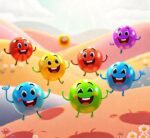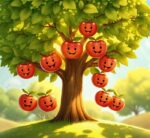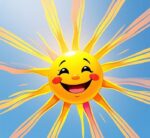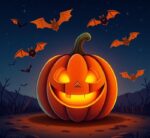- You are here:
- Home »
- words
- » Halloween Words That Start With T [LIST]

Halloween Words That Start With T [LIST]
Halloween is a time of fun, fright, and fascination, filled with all sorts of spooky creatures, mysterious symbols, and eerie traditions. Whether you’re planning a haunted house, dressing up in your favorite costume, or simply enjoying the festivities, it’s always fun to explore the language of the season. From creepy characters to chilling themes, Halloween brings a host of unique words, and many of them start with the letter ‘T’. In this article, we’ll take a closer look at a variety of Halloween-related words that begin with ‘T’, offering a mix of traditional terms and more creative, modern additions to the spooky lexicon.
The letter ‘T’ brings to mind some of the most iconic and chilling aspects of Halloween. From terrifying monsters to the eerie decorations that fill homes and streets, words starting with ‘T’ evoke images of darkness, mystery, and celebration. Whether you’re looking for the perfect term to describe your haunted house, need a new word for your Halloween party theme, or simply enjoy expanding your spooky vocabulary, this list of Halloween words that start with ‘T’ is sure to inspire and excite. Get ready to dive into the eerie world of Halloween through the lens of these tantalizing terms!
Halloween Words That Start With T
1. Trick-or-Treat
Trick-or-Treat is a popular Halloween custom where children visit homes in their neighborhoods, asking for candy by saying ‘Trick or treat.’ The phrase originated in the 1920s and has become a staple of Halloween celebrations around the world.
Examples
- Children go door-to-door shouting ‘Trick or treat!’ in hopes of receiving candy.
- The neighborhood was filled with excited kids dressed as ghosts and goblins, all eager for some trick-or-treating.
- On Halloween night, the tradition of trick-or-treating brings joy to both kids and adults alike.
2. Tombstone
A tombstone is a stone marker placed at the head of a grave to memorialize the deceased. For Halloween, fake tombstones are commonly used in decorations to create a creepy, graveyard atmosphere, evoking the spirits of the dead.
Examples
- The graveyard was lined with old, crumbling tombstones that added an eerie atmosphere to the Halloween party.
- On Halloween night, people set up fake tombstones in their front yards to mimic a spooky cemetery.
- The tombstone read ‘Here Lies The Evil Sorcerer’, a fitting tribute for the haunted house.
3. Tarot Cards
Tarot cards are a deck of 78 cards used for divination and fortune-telling. Each card has its own symbolic meaning, and during Halloween, they are commonly used in mystical rituals or as part of spooky fortune-telling activities.
Examples
- The witch used her tarot cards to predict the future, laying out each card with careful precision.
- Many people visit fortune tellers on Halloween night, seeking insight through the ancient art of tarot card reading.
- Tarot cards often feature symbols like the Moon, Death, and the Devil, making them a spooky addition to any Halloween gathering.
4. Theatrical
The term ‘theatrical’ refers to anything that is dramatic or related to theater. In the context of Halloween, it refers to the over-the-top, dramatic decorations, performances, or costumes that are meant to captivate and scare audiences.
Examples
- The Halloween party featured a theatrical performance of Dracula, complete with costumes and special effects.
- Her theatrical makeup transformed her into a ghoul that scared everyone at the haunted house.
- The theatrical lighting made the shadows in the haunted mansion dance in an unsettling way.
5. Transformation
Transformation is the process of changing in form or appearance, often used in Halloween stories and lore. Witches, werewolves, and other supernatural creatures are commonly depicted undergoing dramatic transformations during Halloween celebrations.
Examples
- In horror films, a werewolf’s transformation is one of the most iconic and terrifying scenes.
- Witches are often depicted casting spells that cause horrifying transformations on Halloween night.
- The Halloween party had a costume contest where the transformation into a terrifying monster earned the highest praise.
6. Tarantula
A tarantula is a large, hairy spider that is often used in Halloween decor to evoke fear. Despite their generally non-aggressive nature, tarantulas are feared by many, making them a popular choice for creating a creepy atmosphere.
Examples
- The haunted house featured a large tarantula as part of its creepy exhibit.
- A tarantula scuttled across the floor, sending shivers down the spines of everyone in the room.
- Fake tarantulas are a common Halloween decoration, used to give a frightful touch to spooky setups.
7. Thriller
‘Thriller’ is a famous song by Michael Jackson, known for its eerie music video that features a group of zombies and creepy supernatural elements. It has become an iconic Halloween anthem and is often played at Halloween parties and events.
Examples
- Michael Jackson’s ‘Thriller’ music video is a Halloween favorite with its iconic zombie dance routine.
- We played the ‘Thriller’ song at the party, and everyone got up to do the famous zombie dance.
- The haunting beats of ‘Thriller’ set the tone for the entire Halloween night.
8. Troll
A troll is a mythical creature, often depicted as a large, ugly monster that lives in caves or under bridges. In Halloween folklore, trolls are associated with mischief and terror, and they are frequently featured in costumes and decorations.
Examples
- The troll under the bridge was said to demand a ransom from anyone who crossed it on Halloween night.
- A troll costume, complete with green face paint and warty skin, was a popular choice at the Halloween costume store.
- The ancient legend of the troll inspired many spooky Halloween stories.
9. Terror
Terror refers to intense fear or dread. During Halloween, terror is a central theme in horror stories, haunted houses, and spooky events, aiming to elicit a visceral, frightened response from participants.
Examples
- The haunted house was designed to induce terror in its visitors with jump scares and creepy sounds.
- A sense of terror gripped the group as they ventured deeper into the dark forest on Halloween night.
- The terror on his face was unmistakable when he saw the ghostly figure appear in front of him.
10. Torch
A torch is a handheld light source, often used in Halloween settings to create an atmosphere of suspense and fear. Torches are a common prop in haunted houses, ghost tours, and Halloween night scenes, often adding a sense of mystery and danger.
Examples
- The flickering torch cast long shadows across the haunted cemetery, creating an eerie effect.
- Witches were often depicted holding torches in the dark, guiding the way to their secret meetings.
- The torchlight illuminated the path through the misty graveyard, setting a chilling scene for the Halloween night.
11. Tomb
A tomb is a structure built to house the remains of the dead, often elaborately decorated and associated with funerary rites. On Halloween, tombs are frequently used as spooky settings for ghost stories and haunted houses.
Examples
- The ancient tomb in the middle of the cemetery was said to be cursed, with strange happenings reported every Halloween night.
- The tombstones surrounding the tomb made the area even more chilling for trick-or-treaters.
- After dark, the tomb seemed to come alive, with strange whispers coming from within.
12. Totem
A totem is an object or symbol that represents a tribe, spirit, or supernatural force. In Halloween folklore, totems are often associated with magical rituals, protection against evil, or as part of the creepy imagery in supernatural practices.
Examples
- The ritual involved placing a spooky totem at the center of the haunted circle.
- A totem carved from bone was displayed prominently at the Halloween party, believed to ward off evil spirits.
- The totem, a carved figure of a skull, was placed on the altar to ensure a successful Halloween ritual.
13. Trance
A trance is a state of altered consciousness where an individual is deeply absorbed or hypnotized. In Halloween traditions, characters often fall into a trance to communicate with spirits, perform magic, or enter another realm.
Examples
- The witch fell into a trance during her ritual, her eyes glowing as she chanted the incantations.
- In the story, the protagonist was hypnotized into a trance by the evil sorcerer on Halloween night.
- The eerie music lulled the dancers into a trance, making the night feel even more otherworldly.
14. Trick
A trick is a prank or mischief, commonly associated with Halloween. The phrase ‘trick-or-treat’ suggests that if a treat isn’t given, a trick may be played instead. Halloween tricks often involve scaring or surprising others in playful ways.
Examples
- On Halloween, some mischievous kids would play a trick if they didn’t get enough candy during trick-or-treating.
- The haunted house was filled with tricks and traps designed to scare the visitors at every turn.
- He played a trick on his friends by hiding in the shadows and jumping out to scare them on Halloween night.
15. Terrorize
To terrorize means to frighten or threaten with extreme fear. On Halloween, many events, from haunted houses to scary movies, are designed to terrorize audiences, playing on common fears and anxieties.
Examples
- The haunted mansion seemed to terrorize visitors with its dark corridors and mysterious sounds.
- The ghost stories told around the fire would terrorize the children, keeping them awake all night.
- A group of pranksters set out to terrorize the neighborhood with their frightening costumes and eerie sound effects.
Historical Context

Halloween, with its deep roots in both ancient and more recent traditions, is a celebration that has evolved over time, incorporating elements from diverse cultures, rituals, and beliefs. Several words associated with Halloween begin with the letter "T," and many of these words are steeped in historical context, carrying with them echoes of old-world customs and practices. Understanding the historical backdrop of these words adds richness to our appreciation of Halloween’s festive significance.
One such word is Trick-or-Treat, a practice that, while now synonymous with Halloween, has a fascinating historical journey. Its origins can be traced to ancient Celtic customs, particularly the Samhain festival, which marked the end of the harvest and the beginning of winter. During Samhain, it was believed that spirits could return to the mortal world, and people would leave food offerings to appease these wandering spirits. The tradition of offering food or treats to spirits evolved over time into the modern-day practice of trick-or-treating, where children go door to door asking for candy, a custom that gained widespread popularity in North America in the 20th century.
Another Halloween word starting with T that holds historical significance is Tombstone. Tombstones, or gravestones, are physical markers that commemorate the dead. The association with Halloween is rooted in the connection between the holiday and death. Samhain, the precursor to Halloween, was a time when the dead were believed to walk among the living, and people often decorated graves with offerings and symbols to honor the spirits. Today, gravestones and tombstones are iconic symbols that often decorate Halloween settings, contributing to the spooky atmosphere.
Then there is Tarot, as in Tarot cards, which, though not strictly a Halloween-specific tradition, has been woven into the fabric of spooky folklore. Tarot reading has long been associated with the mystical and the occult. Its practice, which involves using a deck of cards for divination, likely originated in the 15th century, but it became more entwined with the supernatural during the 18th and 19th centuries. Tarot readings are a common part of Halloween parties or haunted house attractions, adding to the sense of mystery and the unknown.
The historical context of these words gives insight into how Halloween, at its core, has always been about death, the supernatural, and a mingling of both reverence and fear for the unknown.
Word Origins And Etymology
The etymology of Halloween-related words that begin with the letter "T" opens a window into the evolution of language and culture, revealing how language reflects the changing understanding of Halloween traditions and customs.
Take Trick-or-Treat, for example. The word trick derives from the Old French trique, meaning a clever or mischievous act, and treat comes from the Old French traiter, meaning to deal with or entertain. The phrase trick-or-treat was first recorded in the early 20th century, but its roots in mischief and gift-giving can be traced back to medieval customs like "souling" and "guising." In these traditions, poor people would go door-to-door on All Hallow’s Eve asking for food in exchange for prayers or songs for the deceased, laying the foundation for the modern custom.
The word Tombstone comes from the Middle English tombston, a combination of tomb, derived from the Old French tombe, which comes from the Latin tumba, meaning "a burial mound," and stone, which has Germanic origins. Tombstones, as markers of the deceased, have existed since ancient times, with early forms of grave markers being made from stone, wood, or metal. Over time, the function of tombstones evolved to commemorate the deceased in a more permanent and artistic way, often inscribed with names and epitaphs.
The word Tarot has its origins in Italian, specifically the word tarocchi, referring to a deck of playing cards. Tarot cards, however, were not initially associated with fortune-telling. The deck was originally used for playing games in the 15th century in Italy. By the 18th century, however, people began associating tarot cards with mysticism and divination, primarily through the influence of occultists. The word tarot is now inseparable from the idea of fortune-telling, especially during Halloween, when the mysterious and the supernatural are celebrated.
In each case, the evolution of these Halloween words reflects not only the development of language but also the shifting cultural attitudes toward death, the supernatural, and the ways humans interact with the unknown.
Common Misconceptions
Despite the rich history and clear etymology of Halloween words that begin with "T," there are many misconceptions surrounding these terms, often amplified by modern-day media, pop culture, and misunderstandings of their origins.
One of the most common misconceptions is the idea that Trick-or-Treat originated solely as a commercialized custom in the United States during the 20th century. While the practice did gain widespread popularity in America around the 1920s and 1930s, its roots lie in much older European traditions, including the aforementioned souling and guising. The notion that Trick-or-Treat is a wholly American invention overlooks its rich, multicultural origins that span centuries and continents.
Another misconception is the idea that Tombstones and the practice of marking graves with stones have always been associated with Halloween. In truth, the use of tombstones as part of Halloween celebrations is a much more recent phenomenon, heavily influenced by 19th-century Gothic and Victorian aesthetics. While gravestones have long been markers for the dead, their visual prominence in Halloween culture is largely a modern creation. The symbolic association between tombstones and Halloween is as much a product of pop culture as it is of ancient traditions surrounding death.
There are also many misunderstandings about Tarot cards. While they are often linked with Halloween due to their association with fortune-telling and the occult, tarot cards are not inherently tied to the holiday itself. The misconception that tarot reading is strictly for Halloween or associated with witchcraft alone is not entirely accurate. Tarot reading has roots in 15th-century European card games, and while its occult associations grew in the 18th and 19th centuries, it wasn’t always seen as a Halloween-specific activity. Modern Halloween celebrations have, however, integrated tarot readings as part of the broader interest in the mystical, supernatural, and otherworldly that permeates the holiday.
In all of these instances, the myths and misconceptions surrounding Halloween words beginning with "T" reveal how traditions and language can be transformed by popular culture and shifting societal values.
Conclusion
The words associated with Halloween that begin with the letter "T"—Trick-or-Treat, Tombstone, and Tarot—carry with them a deep historical context, rich etymology, and often misunderstood meanings. From ancient Celtic customs to modern-day Halloween celebrations, these words trace the evolution of societal beliefs surrounding death, the supernatural, and the human desire to connect with the unseen. Understanding the origins and historical significance of these words enhances our appreciation of the holiday and deepens our understanding of how traditions, folklore, and language have evolved over time.
By delving into the past, we see that Halloween’s blend of playfulness, fear, and reverence for the unknown has been present for centuries, and through the words we use to describe it, we carry forward these ancient traditions in a modern context. Whether you’re reveling in the fun of Trick-or-Treat, contemplating the spirits near a Tombstone, or exploring the mysteries of Tarot, Halloween is a time to embrace the rich cultural tapestry woven by these words and the stories they tell.








